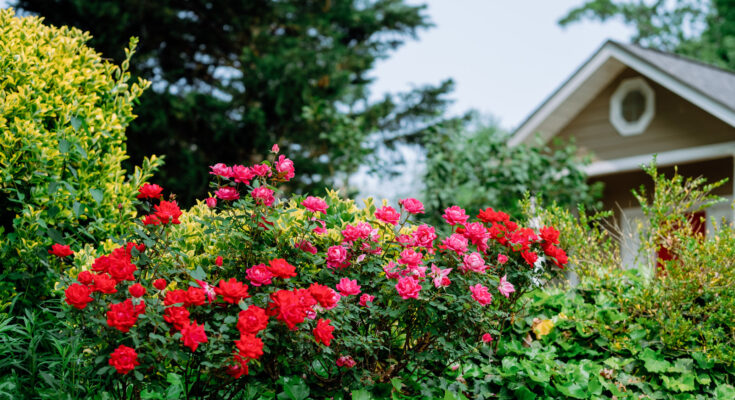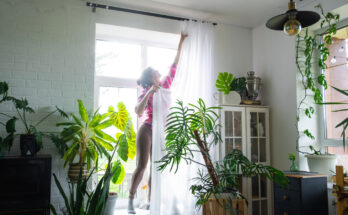20 Gorgeous Shrubs With Pretty Red Flowers That Will Beautify Your Yard
It’s hard not to love red flowers, whether you’re creating a tropical oasis, growing a romantic cottage-style garden, or simply can’t resist this eye-catching shade. As the complementary color of green, fiery blooms pop beautifully against the shrub’s foliage, providing stunning contrast during the blooming season. Even better, flowering shrubs with pretty red flowers are some of the best plants you can use to attract your favorite pollinators, especially hummingbirds. Not only are our favorite tiny birds drawn to red, but it’s also a shade that attracts butterflies.
When using shrubs in your garden, first, make sure you have plenty of space for them to grow, especially if you’re looking at larger varieties. Flowering shrubs covered in red blooms look great in nearly any landscape. The bold colors make them perfect for specimen planting, creating vibrant hedges, or filling in borders with outstanding color. The shrubs below come in all shapes, sizes, and growth habits, so you can add pops of red to your garden, whether you need a compact variety for containers or want a large focal point.
Flowering quince
Flowering quince (Chaenomeles speciosa) is a 6 to 12-foot-tall and wide shrub that brings a burst of scarlet-red blooms to your garden. Clusters of vibrant, five-petaled flowers cover its bare stems in late winter or early spring, drawing in hummingbirds and butterflies searching for early-season nectar. Its glossy, dark green leaves appear shortly after. Hardy in zones 4 through 8, it doesn’t take much to keep this plant happy. Its best flowering is in full sun, though it can handle part shade. Although it isn’t too picky about soil texture, it requires a well-drained, neutral to acidic soil.
Red Buckeye
If you’re searching for the best plants for your pollinator garden, you can’t go wrong with red buckeye (Aesculus pavia), as long as you can accommodate its up to 25-foot growth. Also known as firecracker plant, its clusters of tubular, red flowers appear in spring, acting like magnets to hummingbirds, butterflies, and bees. This stunning native thrives in zones 4 through 8 and prefers part shade conditions, as intense, direct sunlight can scorch its leaves in hot, dry months. Growing best in moist, well-drained soil, it is tolerant of a wide range of soil types and pH levels.
Camellia japonica ‘Kramer’s Supreme’
With its bright red, peony-like blooms, ‘Kramer’s Supreme’ camellia (Camellia japonica) rewards you with a vibrant winter garden when planted in zones 7 through 9. This 8 to 10-foot cultivar is another shrub that puts out its fragrant flowers in late winter to early spring, providing pollinators with much-needed nectar when other sources are scarce. It likes having protection from the afternoon sun, making it a perfect plant for more shaded areas of your garden. Avoid alkaline soils and opt for a moist, well-drained, slightly acidic site.
Torch Azalea
There are several types of azaleas you can grow in your garden, though torch azaleas (Rhododendron kaempferi) are a notable choice for anyone looking for showy red blooms. Reaching up to 10 feet tall and 6 feet wide, its tubular blooms draw in hummingbirds and bees, including a specialist mining bee. This Japanese native is hardy in zones 5 through 7 and is one of the few evergreen flowering shrubs that not only tolerate but also prefer less than 4 hours of light. Plant in well-drained, acidic soils that are rich in organic matter.
Red Prince Weigela
It can be challenging to find flowering plants that are a true, bold red, but red prince weigela (Weigela florida ‘Red Prince’) makes it easy to bring that eye-catching color into your landscape. This 6 to 9-foot deciduous shrub puts on a stunning floral show in late spring to early summer, sometimes reblooming again in late summer to early fall. Like other deep, red tubular flowers, it’s sure to attract more hummingbirds to your garden. You can grow this clay-tolerant cultivar in zones 4 through 8, where its best blooms are in full sun and well-drained soil.
‘Knock Out’ shrub rose
For effortless color that lasts from spring to frost in zones 5 through 9, it’s hard to beat the performance of Rosa ‘Radrazz’ (Rosa ‘Radrazz’ KNOCK OUT). As if its exceptionally long blooming season isn’t incredible enough, it’ll put out its cherry-red roses even in part shade. All it asks for is moist, slightly acidic, well-drained loam, and it’ll do the rest. Because this compact cultivar only reaches 3 to 4 feet, nearly any gardener can fit this bee and butterfly favorite into their landscape. In autumn, its purplish-green leaves turn to attractive shades of burgundy and purple.
Fuchsia-flowered gooseberry
Fuchsia-flowered gooseberry (Ribes speciosum) adds a pop of color to the landscape with its dangling, bright red, fuchsia-like flowers from late winter through spring. The tubular blooms are irresistible to hummingbirds, with one species relying solely on this California native, and other birds love its showy autumn fruits. It typically grows 4 to 6 feet, with arching, thorny stems that make it perfect for naturalized gardens. Although evergreen, drought stress can cause its leaves to drop. Easily grown in zones 7 through 10, it thrives in full sun to part shade and prefers well-drained soil.
Crimson bottle brush
Crimson bottle brush (Melaleuca citrina) is an exotic, 15-foot flowering shrub or small tree that’s a garden must-have for hummingbird lovers. Each flower is made up of long, bright red stamens rather than petals, giving them a spiky appearance that resembles a baby’s bottle brush. Their blooms appear in spring and fall before giving way to seed capsules that are a favorite of birds. This heat-loving plant grows easily in zones 9 through 11, though you can plant it in zone 8 with winter protection. Plant it in moist, rich, well-drained soils in a sunny spot.
Plum leaf azalea
To extend your garden’s color into late summer, consider planting a plum leaf azalea (Rhododendron prunifolium) for its showstopping blooms. With its explosion of large, orangish to deep red flower clusters, your yard will be a hotspot for bees, hummingbirds, and other pollinators. This showy native can mature to be 8 to 20 feet, working well as a specimen plant. Native to the southeastern United States, it thrives in zones 5 through 9 and prefers partial shade with moist, well-drained, slightly acidic soil.
Chinese hibiscus
Few flowering shrubs deliver a tropical vibe quite like Chinese hibiscus (Hibiscus rosa-sinensis). It’s perfect for hot and humid southern climates in zones 9 through 11, where it blooms nearly year-round. There are several cultivars that come in a range of shades, including scarlet and deep red, so check the plant tag if you’re after a red-blooming type. Plant this full-sun lover in rich, well-drained soil, making sure to water and fertilize regularly during the growing season. You can grow it in full sun to partial shade.
Cardinal-spear
Also known as coral bean, cardinal-spear (Erythrina herbacea) is an exotic, herbal perennial shrub that’ll make coastal gardens stand out. Long clusters of its scarlet flowers appear at the tips of branches from May to July, often before the leaves emerge. You can grow this tropical beauty in zones 6 through 9, where its blooms draw in hummingbirds. It’ll happily grow in well-drained clay or sandy loams, reaching up to 12 feet tall and 6 feet wide. It grows well in full sun to partial shade, so it’s a great way to add bold color to shadier garden areas.
Red fairy duster
As a flowering shrub that thrives in dry heat, red fairy duster (Calliandra californica) is a must for a desert garden. Aptly named, each of its flowers is made up of long, vibrant red to fuchsia stamens that appear as a fluffy feather duster. This wildlife magnet blooms from late spring to fall and is a favorite of bees, butterflies, hummingbirds, and other birds. It grows well in arid regions of zones 9 through 12, thriving in full sun and well-drained soil. Growing up to 6 feet tall and wide, this compact shrub fits in nearly any landscape.
Chuparosa
Sometimes referred to as beloperone or hummingbird bush, chuparosa (Justicia californica) is another showy flowering plant that thrives in arid landscapes. Rather than spiky stamens, this Mexican and southern Californian native features bright red, tubular blooms that perfectly suit a hummingbird’s beak. This loose, sprawling shrub can grow up to 6 feet tall and wide, adding vibrant red flowers to desert gardens throughout the year. It performs best in full sun and dry, rocky, or sandy soil in warmer climates, zones 8 through 10.
Shrimp plant
Named for its red-to-pink-bronze, shrimp-like bracts, the shrimp plant (Justicia brandegeeana) adds a touch of whimsy year-round in zones 9 through 11. Hidden inside are white, tubular flowers that attract hummingbirds and other pollinators. This is a gorgeous flowering shrub that thrives in the shade, with its colorful bracts bleaching out with too much direct sunlight. It’s a compact variety that typically reaches 1 to 3 feet in height and width, making it easy to grow in containers. In cooler climates, you can overwinter indoors. Plant it in moist, humusy, well-drained soils.
Red bigleaf hydrangea
Soft shades of blue or pink may come to mind when picturing hydrangeas, but what many gardeners don’t realize is that there are several bigleaf hydrangeas (Hydrangea macrophylla) with the same showy flower heads in rich shades of red. One example, ‘Ruby Red’ features jewel-toned blooms that deepen to a red-wine hue as they mature. Alternatively, ‘Red Sensation’ is a compact, reblooming variety with clusters of rich, bright red flowers. Bigleaf hydrangeas are hardy in zones 6 through 11 and thrive in moist, well-drained soil. Disliking direct sun, they’re perfect for flourishing shade gardens.
Egyptian star cluster
Egyptian star cluster (Pentas lanceolata) is a small, upright shrub or tall perennial that stays at a compact height and width of 3 to 4 feet. It comes in several shades, though the vibrant red varieties are most appetizing to hummingbirds. Luckily, deer don’t find them as palatable. It grows as a perennial in zones 10 through 11 but functions as an annual in cooler regions. Plant in acidic, well-drained soil, and once established, it’s extremely drought-tolerant. Although it can tolerate partial shade, it’ll put out more blooms when planted in full sun.
Chinese fringe flower ‘Ever Red’
Why settle for just red blooms when you can have an entire shrub in shades of burgundy and crimson? With Chinese fringe flower ‘Ever Red’ (Loropetalum chinense ‘Ever Red’), you get clusters of rich crimson-red flowers atop stems covered in burgundy foliage that stays vibrant all summer. You can add this 6-foot evergreen plant to gardens in zones 7 through 9 to enjoy its late winter or spring blooms. It grows best in well-drained soil, planted in an area where it receives some protection from intense afternoon sun.
Witch hazel ‘Rubin’
It’s hard to resist the appeal of witch hazel ‘Rubin’ (Hamamelis × intermedia ‘Rubin’), a hybrid that offers beauty across multiple seasons. In late winter to early spring, its ruby red, spidery blooms emerge on leafless branches. Its dark green foliage lines the branches in spring and summer before turning yellowish-orange in autumn. For the healthiest growth, the best place to plant witch hazel in your garden is one with full sun and organically rich, acidic, well-drained soil. It’s hardy in zones 5 through 8 and reaches 9 to 12 feet tall and wide.
Crape myrtle ‘Dynamite’
If you have the yard space for this up to 20-feet-tall and 15-feet-wide beauty, crape myrtle ‘Dynamite’ (Lagerstroemia ‘Dynamite’) makes a breathtaking specimen or hedge you can plant for privacy in your yard. This large shrub puts out masses of ruffled red flowers along the tips of its branches in summer. In fall, the leaves turn attractive shades of yellow to red before dropping when temperatures cool. Hardy in zones 6 through 10, it grows easily in moist, well-drained, average soil in a sunny area of your garden.
Peacock flower
Also nicknamed Mexican bird of paradise or pride of Barbados, peacock flower (Caesalpinia pulcherrima) is famous for its profusion of fiery, orangeish-red blooms with long, bright red stamens. As a tropical American native, it grows best in hot and humid climates in zones 9 through 11. For the best flowering, plant it in an area with full sun and fertile, well-drained soil. Although younger plants need regular watering, they’re quite drought-tolerant once established. With its fern-like foliage and year-round blooms, it’s perfect for those starting a winter garden in warmer regions.



